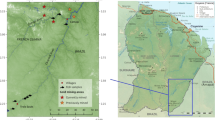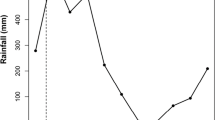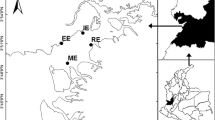Abstract
The Brazilian Amazon is heavily impacted by mining activities, especially by gold and cassiterite mining. Pb is a contaminant released during cassiterite extraction, and it stands out for its high toxicity. The present study aimed to evaluate the effect of flood pulse on Pb dynamics in four fish species with different feeding habits (Cichlapleiozona: carnivorous, Mylossomaduriventre: herbivorous, Prochilodus nigricans: detritivorous, and Serrasalmus rhombeus: piscivorous) over four hydrological periods in Puruzinho Lake (Brazilian Amazon), which receives water from the Madeira River. The risk assessment for daily Pb intake through the consumption of these fish by the local riverside population was also carried out. Fish species were sampled during four Amazonian hydrological periods: rising water, high water, falling water, and low water. Pb and stable isotopes (δ15N and δ13C) measurements were carried out on fish muscle. The flood pulse had the same effect on Pb concentrations of all the fish species regardless of their feeding habits, as we found a nonsignificant interaction between these variables. The Pb in fish muscle increased in the flood season (rising and high water) and decreased in the dry season (falling and low water). The Pb concentration in fish increased significantly with their trophic level (δ15N), evidencing the occurrence of biomagnification of the element along the trophic chain (R2 = 0.24). The main food source of the herbivorous fish (δ13C) was very distinct from that of the others, which had a large overlap in their values. Regarding risk assessment, the daily Pb intake through consumption of the herbivorous species during high water (17.82 ± 19.68 µg∙day−1) exceeded the limit determined by the Food and Drug Administration (FDA) of 12.5 µg∙day−1, representing a health risk to the riverside population of Puruzinho Lake.




Similar content being viewed by others
Data availability
The data that support the findings of this study are available from the corresponding author, I.A. Pestana, upon reasonable request.
References
Altman N, Krzywinski M (2016) Regression diagnostics. Nat Methods 13:385–386. https://doi.org/10.1038/nmeth.3854
Agência Nacional de Águas (ANA), 2019. Rede Hidrometeorológica Nacional, Sistema HIDRO - Telemetria, Estaçao Humaitá, Código 15630000. Available at: http://www.snirh.gov.br/gestorpcd/gerarGrafico.aspx(Accessed 20 March 2022)(in Portuguese)
ANVISA. Agência Nacional de Vigilância Sanitária. 2013. Resolução - RDC Nº 42, de 29 de agosto de 2013. Dispõe sobre o Regulamento Técnico MERCOSUL sobre Limites Máximos de Contaminantes Inorgânicos em Alimentos. Available at: http://www.cidasc.sc.gov.br/defesasanitariaanimal/files/2021/08/RDC-n%C2%BA-42-de-29-de-agosto-de-2013.pdf(Accessed 20 March 2022) (in Portuguese)
ANVISA. Agência de Vigilância Sanitária. 2021. Instrução Normativa - IN N° 88. Estabelece os limites máximos tolerados (LMT) de contaminantes em alimentos.Available at: https://www.in.gov.br/en/web/dou/-/instrucao-normativa-in-n-88-de-26-de-marco-de-2021-311655598(Accessed 20 March 2022) (in Portuguese)
Arcagni M, Juncos R, Rizo A, Pavlin M, Fajon V, Arribére MA, Horvat M, Guevara SR (2018) Species- and habitat-specific bioaccumulation of total mercury and methylmercury in the food web of a deep oligotrophic lake. Sci Total Environ 612:1311–1319. https://doi.org/10.1016/j.scitotenv.2017.08.260
Azevedo LS, Pestana IA, da Costa Nery AF, Bastos WR, Souza CMM (2020) Mercury concentration in six fish guilds from a floodplain lake in western Amazonia: interaction between seasonality and feeding habits. Ecol Indic 111:106056. https://doi.org/10.1016/j.ecolind.2019.106056
Azevedo LS, Pestana IA, Almeida MG, Bastos WR, Souza CMM (2021) Do fish isotopic niches change in an Amazon floodplain lake over the hydrological regime? Ecol Freshw Fish 31(1):72–80. https://doi.org/10.1111/eff.12609
Barbosa-Jr F, Fillion M, Lemire M, Passos CJS, Rodrigues JL, Philibert A, Guimarães JR, Mergler D (2009) Elevated blood lead levels in a riverside population in the Brazilian Amazon. Environ Res 109(5):594–599. https://doi.org/10.1016/j.envres.2009.03.005
Bassey OB, Chukwu LO (2019) Health risk assessment of heavy metals in fish (Chrysichthys nigrodigitatus) from two lagoons in southwestern Nigeria. J Toxicol Risk Assess 5(2):027. https://doi.org/10.23937/2572-4061.1510027
Bastos WR, Gomes JPO, Oliveira RC, Almeida R, Nascimento EL, Bernardi JVE, Lacerda LD, Silveira EG, Pfeiffer WC (2006) Mercury in the environment and riverside population in the Madeira River Basin, Amazon. Braz Sci Total Environ 368(1):344–351. https://doi.org/10.1016/j.scitotenv.2005.09.048
Bastos WR, Malm O, Pfeifer WC, Cleary D (1998) Establishment and analytical quality control of laboratories for Hg determination in biological and geological samples in the Amazon, Brazil. Rev. Ciên. Cult. 50:255–260. Available at: https://biogeoquimica.unir.br/uploads/42029128/arquivos/Cien_1728929093.pdf(Accessed 20 March 2022)
Cardwell, R.D., DeForest, D.K., Brix, K.V., Adams, W.J. 2013. Do Cd, Cu, Ni, Pb, and Zn biomagnify in aquatic ecosystems?. In: Whitacre, D. (eds) Reviews of environmental contamination and toxicology Volume 226. Reviews of environmental contamination and toxicology, vol 226. Springer, New York, NY. https://doi.org/10.1007/978-1-4614-6898-1_4
Carvalho, D.P. de, Almeida, R. de, Manzatto, Â.G., Freitas, O.B. de, Bastos, W.R., 2018. Dynamics of metals in lacustrine sediments: case study of the Madeira River, Amazon region. Brazilian J. Water Resour. 23. https://doi.org/10.1590/2318-0331.231820170026
Cella-Ribeiro A, Torrente-Vilara G, Lima-Filho JA, Doria CRC (2016) Ecologia e Biologia de peixes do Rio Madeira. EDUFRO, PortoVelho. 350. https://doi.org/10.47209/978-85-7764-086-7
de Almeida R, Bernardi JVE, Oliveira RC, de Carvalho DP, Manzatto AG, de Lacerda LD, Bastos WR (2014) Flood pulse and spatial dynamics of mercury in sediments in Puruzinho lake. Braz Amazon Acta Amaz 44:99–105. https://doi.org/10.1590/s0044-59672014000100010
Dolan LC, Flannery BM, Hoffman-Pennesi D, Gavelek A, Jones OE, Kanwal R, Wolpert B, Gensheimer K, Dennis S, Fitzpatrick S (2020) A review of the evidence to support interim reference level for dietary lead exposure in adults. Regul Toxicol Pharmacol 111:104579. https://doi.org/10.1016/j.yrtph.2020.104579
FAO. Food and Agriculture Organization. 2016. Fishery and aquaculture country profiles–the Republic of Maldives. Avaliable at: https://www.fao.org/figis/pdf/fishery/facp/MDV/en?title=FAO%20Fisheries%20%26(Accessed 20 March 2022)
FAO/WHO, 2014. Codex Alimentarius: guidelines for the simple evaluation of dietary exposure to food 605 additives CAC/GL 3–1989. Avaliable at: https://www.fao.org/input/download/standards/6/cxg_003e.pdf(Accessed 20 March 2022)
Feitosa IB, Huszar VLM, Domingues CD, Appel E, Paranhos R, Almeida RM, Branco CWC, Bastos WR, Sarmento H (2019) Plankton community interactions in an Amazonian floodplain lake, from bacteria to zooplankton. Hydrobiologia 831:55–70. https://doi.org/10.1007/s10750-018-3855-x
Flannery BM, Dolan LC, Hoffman-Pennesi D, Gavelek A, Jones OE, Kanwal R, Wolpert B, Gensheimer K, Dennis S, Fitzpatrick S (2020) US Food and Drug Administration’s interim reference levels for dietary lead exposure in children and women of childbearing age. Regul. Toxicol. Pharmacol. 110:104516. https://doi.org/10.1016/j.yrtph.2019.104516
Fox J, Weisberg S (2019) An {R} companion to applied regression, 3rd edn. Sage, Thousand Oaks CA, p 608. Availablet at: https://socialsciences.mcmaster.ca/jfox/Books/Companion/
Fry B (2006) Stable Isotope Ecology. New York, NY: Springer.308. https://doi.org/10.1007/0-387-33745-8
Guimarães JRD (2020) Mercury in the Amazon: problem or opportunity? A commentary on 30 years of research on the subject. Elementa: Science of the Anthropocene 8(1):032. https://doi.org/10.1525/elementa.032
Hacon S, Vega C, Hacon B, Carvalho DP, Almeida R, Barbosa R, Bastos IB (2010) Lead human health risk assessment case study: cassiterite mining in the western Brazilian Amazon. Braz Toxicol Letters 196:S66. https://doi.org/10.1016/j.toxlet.2010.03.252
Hiane PA, Leal Filho AF, Ramos Filho MM, Ramos MIL (2002) Teores de colesterol e lipídios totais em seis espécies de peixes capturados na região pantaneira do estado do Mato Grosso do Sul. B CEPPA 20(1):5–74. https://doi.org/10.5380/cep.v20i1.1136
Huser BJ, Fölster J, Köhler SJ (2012) Lead, zinc, and chromium concentrations in acidic headwater streams in Sweden explained by chemical, climatic, and land-use variations. Biogeosci 9(11):4323–4335. https://doi.org/10.5194/bg-9-4323-2012
Inhamuns AJ (2000) Composição de ácidos graxos de peixes de água doce da região amazônica brasilieira. PhD thesis. Universidade Estadual de Campinas.Repositório de produção científica e intelectual da Unicamp. Available at: http://repositorio.unicamp.br/jspui/handle/REPOSIP/255038(Accessed 20 March 2022) (in Portuguese)
Inhamuns AJ, Franco MRB (2008) EPA and DHA quantification in two species of freshwater fish from Central Amazonia. Food Chem 107:587–591. https://doi.org/10.1016/j.foodchem.2007.07.032
Ishitsuka K, Yamamoto-Hanada K, Yang L, Mezawa H, Konishi M, Saito-Abe M, Sasaki H, Nishizato M, Sato M, Koeda T, Ohya Y (2020) Association between blood lead exposure and mental health in pregnant women: results from the Japan environment and children’s study. Neurotoxicol 79:191–199. https://doi.org/10.1016/j.neuro.2020.06.003
Jakubus M (2020) Changes in lead and chromium contents in sewage sludge evaluated using both single extractants and sequential method. Environ Pollutants Bioavailab 32(1):87–99. https://doi.org/10.1080/26395940.2020.1778541
Jiang Z, Xu N, Liu B, Zhou L, Wang J, Wang C, Dai B, Xiong W (2018) Metal concentrations and risk assessment in water, sediment and economic fish species with various habitat preferences and trophic guilds from Lake Caizi, Southeast China. Ecotoxicol Environ Saf 157:1–8. https://doi.org/10.1016/j.ecoenv.2018.03.078
Khitalishvili K (2016) Monte Carlo simulation in R: basic example. Avaliable at: https://rpubs.com/Koba/Monte-Carlo-Basic-Example(Accessed 20 March 2022)
Lacerda LD, Salomons W (1998) Mercury from gold and silver mining: a chemical time bomb? Springer, Berlin, Heidelberg 147. https://doi.org/10.1007/978-3-642-58793-1
Lacerda LD, Malm O (2008) Mercury contamination in aquatic ecosystems: an analysis of the critical areas. Dossiê Água: Estudos Avançados 22(63):173–190. https://doi.org/10.1590/S0103-40142008000200011
Liu H, Liu G, Wang S, Zhou C, Yan Z, Da C (2018) Distribution of heavy metals, stable isotope ratios (δ13C and δ15N) and risk assessment of fish from the Yellow River Estuary, China. Chemosphere 208:731–739. https://doi.org/10.1016/j.chemosphere.2018.06.028
Longo RM, Ribeiro AÍ, Melo WJ (2011) Uso da adubação verde na recuperação de solosdegradados por mineração na floresta amazônica. Bragantia 70(1):139–146. https://doi.org/10.1590/S0006-87052011000100020(inPortuguese)
McConnaughey T, McRoy CP (1979) Food-web structure and the fractionation of carbon isotopes in the Bering Sea. Mar Biol 53(3):257–262. https://doi.org/10.1007/BF00952434
Melo, D., Roseno, T.F., Barros, W.M., Faria, R.A.P.G., Paglarini, C.S., Faria, P.B., Mariotto, S., Souza, X.R. 2019. Fatty acid profiles and cholesterol content of five species of pacu-pevas from the pantanal region of Mato Gross, Brazil. Journal of Food Composition and Analysis, 83. https://doi.org/10.1016/j.jfca.2019.103283
Moreira FR, Moreira JC (2004) A cinética do chumbo no organismo humano e sua importância para a saúde. Ciênc Saúde Coletiva 9(1):167–181. https://doi.org/10.1590/S1413-81232004000100017
Mushak P (2011) Lead exposure in human populations: lead intakes. Trace Met Other Contam Environ 10:217–241. https://doi.org/10.1016/B978-0-444-51554-4.00007-9
Nascimento LS, Silva LO, Azevedo SM, Almeida R, Almeida MG, Azevedo LS, Bastos WR, Souza CMM, Pestana IA (2022) Spatial-temporal dynamics of Cr in fish from Puruzinho lake (western Amazon) and dietary risk assessment. Chemosphere 300:134576. https://doi.org/10.1016/j.chemosphere.2022.134576
Nascimento EL, Gomes JPO, Almeida R, Bastos WR, Bernardi, JVE, Miyai RK (2007) Mercúrio no plâncton de um lago natural amazônico, lago Puruzinho (Brasil). J. Braz. Soc. Ecotoxicol, 2(1): 67–72. Available at: https://ecotoxbrasil.org.br/upload/0eafe803266347f3c0fe0bc4a216f5ea-10_v2n1.pdf(Accessed 20 March 2022) (in Portuguese)
Nash RDM, Valencia AH, Geffen AJ (2006) The origin of Fulton’s condition factor—setting the record straight. Fisheries 31(5):236–238.Available at:https://folk.uib.no/nfiag/nfiag/reprints/Nashetal%202006FISH.pdf (Accessed 20 March 2022)
Nriagu Jo, Pfeiffer WC, Malm O, Souza CMM, Mierle G (1992) Mercury pollution in Brazil. Nature 356(2):389–390. https://doi.org/10.1038/356389a0
Oliveira RC, Dórea JG, Bernardi JV, Bastos WR, Almeida R, Manzatto ÂG (2010) Fish consumption by traditional subsistence villagers of the Rio Madeira (Amazon): impact on hair mercury. Ann Hum Biol 37(5):629–642. https://doi.org/10.3109/03014460903525177
Pestana IA, Almeida MG, Bastos WR, Souza CMM (2019) Total Hg and methylmercury dynamics in a river-floodplain system in the western Amazon: influence of seasonality, organic matter and physical and chemical parameters. Sci Total Environ 656:388–399. https://doi.org/10.1016/j.scitotenv.2018.11.388
Pestana IA, Rezende CE, Almeida R, Lacerda LD, Bastos WR (2022) Let’s talk about mercury contamination in the Amazon (again): the case of the floating gold miners’ village on the Madeira River. In press, The Extractive Industries and Society. https://doi.org/10.1016/j.exis.2022.101122
Pfeiffer WC, Lacerda LD (1988) Mercury inputs into the Amazon region, Brazil. Environ Technol Lett 9(4):325–330. https://doi.org/10.1080/09593338809384573
Queiroz TKL, Naka KS, Mendes LCS, Costa BNS, Jesus IM, Câmara VM, Lima MO (2019) Human blood lead levels and the first evidence of environmental exposure to industrial pollutants in the Amazon. Int J Environ Res Public Health 16(17):3047. https://doi.org/10.3390/ijerph16173047
R Core Team, 2022. R: a language and environment for statistical computing. RFoundation for Statistical Computing. Austria, Vienna. Availablet at: http://www.R-project.org/
Ribeiro DRG, Faccin H, Molin TRD, Carvalho LM, Amado LL (2017) Metal and metalloid distribution in different environmental compartments of the middle Xingu River in the Amazon, Brazil. Sci Total Environ 605–606:66–74. https://doi.org/10.1016/j.scitotenv.2017.06.143
Ricker WE (1975) Computation and interpretation of biological statistics of fish populations. Bulletin of the Fisheries Research Board of Canada 191:1–382. Available at: https://waves-vagues.dfo-mpo.gc.ca/library-bibliotheque/1485.pdf (Accessed 20 March 2022)
Rudke AP, Souza VAS, Santos AM, Xavier ACF, Filho OCR, Martins JA (2020) Impact of mining activities on areas of environmental protection in the southwest of the Amazon: a GIS- and remote sensing-based assessment. J Environ Manage 263:110392. https://doi.org/10.1016/j.jenvman.2020.110392
Schifer TS, Bogusz-Jr S, Montano MAE (2005) Aspectos toxicológicos do chumbo. Infarma, (5):67–72.Available at: https://revistas.cff.org.br/infarma/article/view/273 (Accessed 20 March 2022) (in Portuguese)
Sioli H (1968) Hydrochemistry and geology in the Brazilian Amazon region. Amazoniana: Limnologia et Oecologia Regionalis Systematis Fluminis Amazonas, 1(3):267–277.Available at: http://hdl.handle.net/21.11116/0000-0004-5124-8 (Accessed 20 March 2022)
Sonoda DY, & Shirota R (2012) Consumo de pescado no Brasil fica abaixo da média internacional. Visão agrícola, 8(11):145–147. Available at: https://www.esalq.usp.br/visaoagricola/sites/default/files/va11-mercado-e-consumo01.pdf (Accessed 20 March 2022) (in Portuguese)
Sousa, E. A. D., Miranda, M. R., dos Santos, M. H., Costa Júnior, W. A., Lauthartte, L.C., Mussy, M. H., ... & Bastos, W. R. (2015). Assessment of trace metals in Amazonian fish exposed to untreated urban sewage: high chromium concentrations in fish tissues. Revista Ambiente & Água, 10(3), 499-509. https://doi.org/10.4136/ambi-agua.1594
Souza-Araujo J, Hussey N, Hauser-Davis RA, Rosa AH, Lima MO, Giarrizzo T (2022) Human risk assessment of toxic elements (As, Cd, Hg, Pb) in marine fish from the Amazon. Chemosphere 301:134575. https://doi.org/10.1016/j.chemosphere.2022.134575
Stierman B, Hauptman M, Woolf AD (2020) Severe lead poisoning requiring hospitalization: a case report. Curr Probl Pediatr Adolesc Health Care 50:1–5. https://doi.org/10.1016/j.cppeds.2020.100757
UNEP. 2010. United Nations Environment Programme. Final review of scientific information on lead. Available at: https://www.cms.int/sites/default/files/document/UNEP_GC26_INF_11_Add_1_Final_UNEP_Lead_review_and_apppendix_Dec_2010.pdf(Accessed 20 March 2022)
Venables WN, Ripley BD (2002) Modern applied statistics with S. Fourth Edition. Springer, New York. ISBN 0–387–95457–0.https://doi.org/10.1007/978-0-387-21706-2
Vries ANV, Govoni D, Árnason SH, Carlsson P (2020) Microplastic ingestion by fish: body size, condition factor and gut fullness are not related to the amount of plastics consumed. Mar Pollut Bull 151:110827. https://doi.org/10.1016/j.marpolbul.2019.110827
Yi Y, Tang C, Yi T, Yang Z, Zhang S (2017) Health risk assessment of heavy metals in fish and accumulation patterns in food web in the upper Yangtze River, China. Ecotoxicol Environ Saf 145:295–302. https://doi.org/10.1016/j.ecoenv.2017.07.022
Funding
This work was supported by CNPq (Conselho Nacional de Desenvolvimento Científico e Tecnológico) through the CNPq/CTUniversal project (Grant no. 458977 2014–4). Inácio A. Pestana received support from Fundação Carlos Chagas Filho de Amparo à Pesquisa do Estado do Rio de Janeiro (FAPERJ; grant numbers E-26/200.586/2022and E-26/210.350/2022).
Author information
Authors and Affiliations
Contributions
Sophia Menezes de Azevedo: writing (original draft and review and editing); Luiza Silva do Nascimento: writing (review and editing); Layra de Oliveira Silva: writing (review and editing); Marcelo Gomes de Almeida: validation and methodology; Lucas Silva Azevedo: writing (review and editing); Wendel Dias Constantino: writing (review and editing); Wanderley Rodrigues Bastos: resources and funding acquisition; Inácio Abreu Pestana: conceptualization, project administration, supervision, and writing (review and editing).
Corresponding author
Ethics declarations
Consent to publish
All the authors agreed with the content of this manuscript and gave explicit consent for submission.
Competing interests
The authors declare no competing interests.
Additional information
Responsible Editor: Severine Le Faucheur
Publisher's note
Springer Nature remains neutral with regard to jurisdictional claims in published maps and institutional affiliations.
Supplementary Information
Below is the link to the electronic supplementary material.
Rights and permissions
Springer Nature or its licensor (e.g. a society or other partner) holds exclusive rights to this article under a publishing agreement with the author(s) or other rightsholder(s); author self-archiving of the accepted manuscript version of this article is solely governed by the terms of such publishing agreement and applicable law.
About this article
Cite this article
de Azevedo, S.M., do Nascimento, L.S., de Oliveira Silva, L. et al. Flood pulse as a driving force of Pb variation in four fish guilds from Puruzinho Lake (western Amazon). Environ Sci Pollut Res 30, 38728–38737 (2023). https://doi.org/10.1007/s11356-022-25015-z
Received:
Accepted:
Published:
Issue Date:
DOI: https://doi.org/10.1007/s11356-022-25015-z




